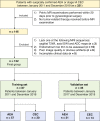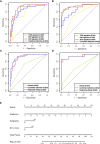Multimodal MRI-Based Radiomics-Clinical Model for Preoperatively Differentiating Concurrent Endometrial Carcinoma From Atypical Endometrial Hyperplasia
- PMID: 35692806
- PMCID: PMC9186045
- DOI: 10.3389/fonc.2022.887546
Multimodal MRI-Based Radiomics-Clinical Model for Preoperatively Differentiating Concurrent Endometrial Carcinoma From Atypical Endometrial Hyperplasia
Abstract
Objectives: To develop and validate a radiomics model based on multimodal MRI combining clinical information for preoperative distinguishing concurrent endometrial carcinoma (CEC) from atypical endometrial hyperplasia (AEH).
Materials and methods: A total of 122 patients (78 AEH and 44 CEC) who underwent preoperative MRI were enrolled in this retrospective study. Radiomics features were extracted based on T2-weighted imaging (T2WI), diffusion-weighted imaging (DWI), and apparent diffusion coefficient (ADC) maps. After feature reduction by minimum redundancy maximum relevance and least absolute shrinkage and selection operator algorithm, single-modal and multimodal radiomics signatures, clinical model, and radiomics-clinical model were constructed using logistic regression. Receiver operating characteristic (ROC) analysis, calibration curves, and decision curve analysis were used to assess the models.
Results: The combined radiomics signature of T2WI, DWI, and ADC maps showed better discrimination ability than either alone. The radiomics-clinical model consisting of multimodal radiomics features, endometrial thickness >11mm, and nulliparity status achieved the highest area under the ROC curve (AUC) of 0.932 (95% confidential interval [CI]: 0.880-0.984), bootstrap corrected AUC of 0.922 in the training set, and AUC of 0.942 (95% CI: 0.852-1.000) in the validation set. Subgroup analysis further revealed that this model performed well for patients with preoperative endometrial biopsy consistent and inconsistent with postoperative pathologic data (consistent group, F1-score = 0.865; inconsistent group, F1-score = 0.900).
Conclusions: The radiomics model, which incorporates multimodal MRI and clinical information, might be used to preoperatively differentiate CEC from AEH, especially for patients with under- or over-estimated preoperative endometrial biopsy.
Keywords: endometrial hyperplasia; endometrial neoplasms; magnetic resonance imaging; radiomics; texture analysis.
Copyright © 2022 Zhang, Zhang, Wang, Song, Yu, Xie, Chen and Ouyang.
Conflict of interest statement
Author LX was employed by GE Healthcare. The remaining authors declare that the research was conducted in the absence of any commercial or financial relationships that could be construed as a potential conflict of interest.
Figures






Similar articles
-
MRI-based radiomics model for distinguishing endometrial carcinoma from benign mimics: A multicenter study.Eur J Radiol. 2022 Jan;146:110072. doi: 10.1016/j.ejrad.2021.110072. Epub 2021 Nov 27. Eur J Radiol. 2022. PMID: 34861530
-
Radiomics analysis of multiparametric MRI for the preoperative evaluation of pathological grade in bladder cancer tumors.Eur Radiol. 2019 Nov;29(11):6182-6190. doi: 10.1007/s00330-019-06222-8. Epub 2019 Apr 23. Eur Radiol. 2019. PMID: 31016445
-
[Application of MRI-based Radiomics Models in the Assessment of Hepatic Metastasis of Rectal Cancer].Sichuan Da Xue Xue Bao Yi Xue Ban. 2021 Mar;52(2):311-318. doi: 10.12182/20210360202. Sichuan Da Xue Xue Bao Yi Xue Ban. 2021. PMID: 33829708 Free PMC article. Chinese.
-
Preoperative Cervical Lymph Node Metastasis Prediction in Papillary Thyroid Carcinoma: A Noninvasive Clinical Multimodal Radiomics (CMR) Nomogram Analysis.J Oncol. 2023 Mar 9;2023:3270137. doi: 10.1155/2023/3270137. eCollection 2023. J Oncol. 2023. PMID: 36936372 Free PMC article.
-
Multi-Parametric Magnetic Resonance Imaging-Based Radiomics Analysis of Cervical Cancer for Preoperative Prediction of Lymphovascular Space Invasion.Front Oncol. 2022 Jan 12;11:663370. doi: 10.3389/fonc.2021.663370. eCollection 2021. Front Oncol. 2022. PMID: 35096556 Free PMC article.
Cited by
-
Advances in Radiomics Research for Endometrial Cancer: A Comprehensive Review.J Cancer. 2023 Oct 24;14(18):3523-3531. doi: 10.7150/jca.89347. eCollection 2023. J Cancer. 2023. PMID: 38021155 Free PMC article. Review.
-
Radiomics model based on multi-sequence MRI for preoperative prediction of ki-67 expression levels in early endometrial cancer.Sci Rep. 2023 Dec 12;13(1):22052. doi: 10.1038/s41598-023-49540-0. Sci Rep. 2023. PMID: 38086918 Free PMC article.
-
Performance of MRI for Detection of ≥pT1b Disease in Local Staging of Endometrial Cancer.Cancers (Basel). 2024 Mar 13;16(6):1142. doi: 10.3390/cancers16061142. Cancers (Basel). 2024. PMID: 38539477 Free PMC article.
-
Few-shot learning to identify atypical endometrial hyperplasia and endometrial cancer based on transvaginal ultrasonic images.Heliyon. 2024 Aug 16;10(16):e36426. doi: 10.1016/j.heliyon.2024.e36426. eCollection 2024 Aug 30. Heliyon. 2024. PMID: 39253160 Free PMC article.
-
Accuracy of radiomics in the diagnosis and preoperative high-risk assessment of endometrial cancer: a systematic review and meta-analysis.Front Oncol. 2024 Jan 25;14:1334546. doi: 10.3389/fonc.2024.1334546. eCollection 2024. Front Oncol. 2024. PMID: 38344208 Free PMC article.
References
-
- Baak JP, Mutter GL, Robboy S, van Diest PJ, Uyterlinde AM, Orbo A, et al. . The Molecular Genetics and Morphometry-Based Endometrial Intraepithelial Neoplasia Classification System Predicts Disease Progression in Endometrial Hyperplasia More Accurately Than the 1994 World Health Organization Classification System. Cancer (2005) 103(11):2304–12. doi: 10.1002/cncr.21058 - DOI - PMC - PubMed
LinkOut - more resources
Full Text Sources

